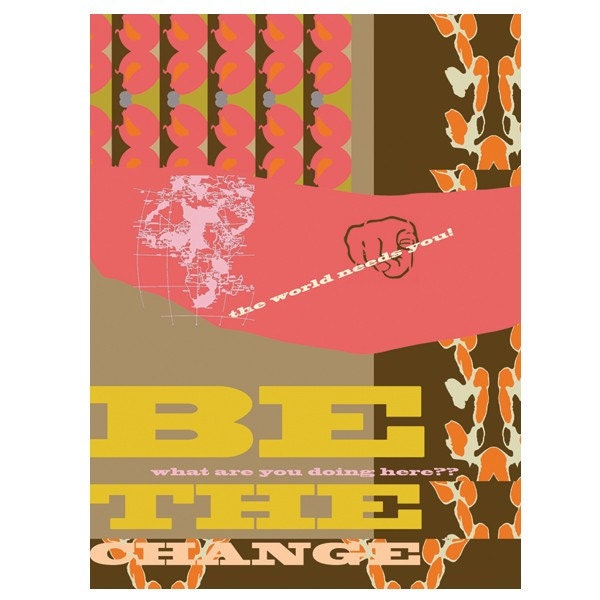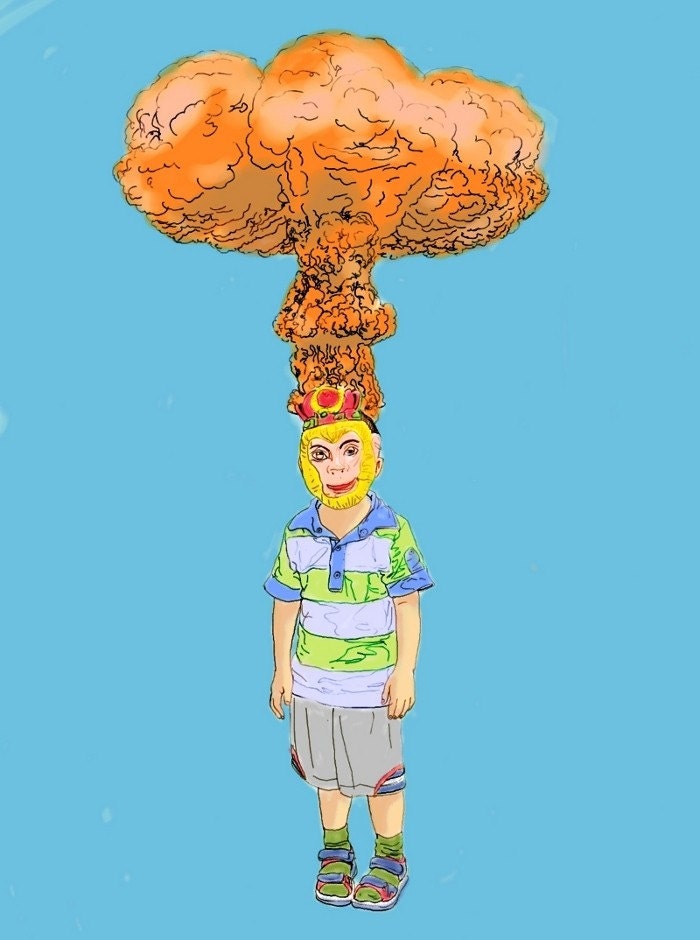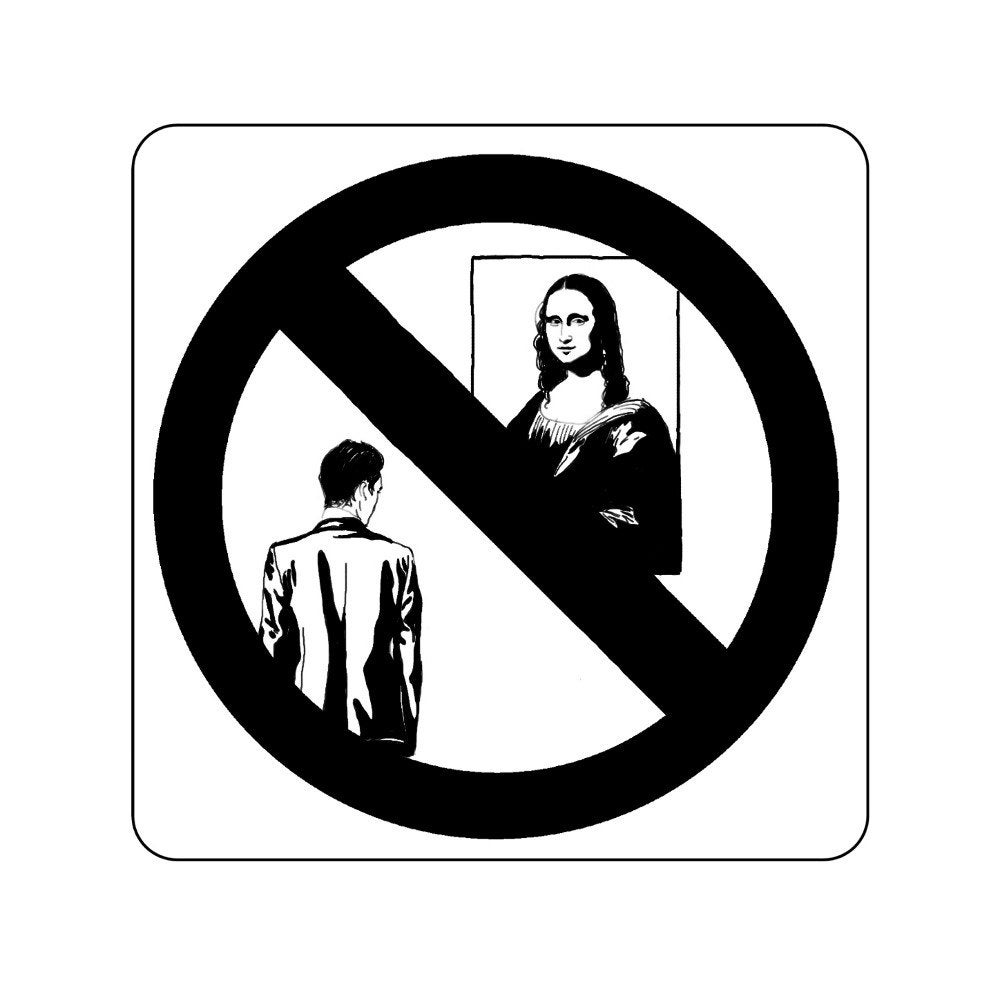The MAKING CHANGE Etsy team is for artists committed to activism. Please tell us what issues are important to you.
I am concerned with a pretty broad spectrum of issues facing our world today. Everyday it seems I hear of a new tragedy ensuing in the world, whether it effects people, animals or the environment. That's why it's so important that we all do our very best to create change and help turn these stories into positive ones. Some of the issues my current work addresses are the importance of accepting and loving other people no matter their religion or race, the need to treat all beings on this planet with value and care, working to stop human trafficking, rescuing child soldiers and ending the wars and genocide, bringing awareness to the mounting global water crisis, transforming our education system to see children as individuals and reconnect them with the world and with nature and promoting sustainable development in third world countries. Other issues that are very important to me are fighting for indigenous rights and cultural preservation, working to create solutions for the global epidemic of homeless children, supporting family farms and sustainable farming practices and ending government support of commercial farms that churn out toxic food and treat animals with unspeakable cruelty.
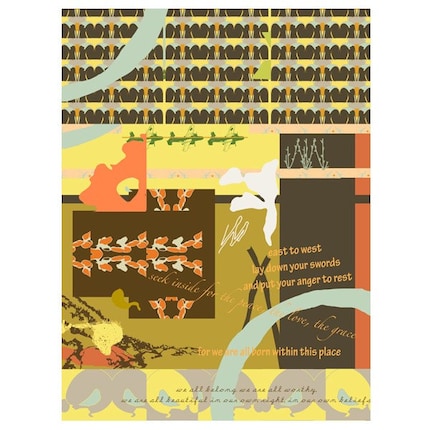
How is the idea of activism apparent in your art?
I think the idea of activism is most apparent in my 'Bring The Change' collection, which is all about bringing attention to the problems our world is facing and encouraging people to look inside themselves and become a part of the solution. Many of these pieces incorporate text, which gives the viewer a clearer idea of the message the piece coveys, but each element of the imagery also has important meaning. For example the print [at left], 'Peace Within' is about ending war, genocide and hate; at the top of the piece you can see what looks like a leaf or a flower poking through the background -- this represents hope. The birds at the bottom of this piece represent harmony and peace and love and care for others. But conversely, the birds can also be seen to represent the struggle, the face-off, between two people who are in essence the same and yet are living in their own bubble and enact hatred towards one another out of ignorance. Every symbol or image in these pieces represents a part of an overall message, but as seen with the birds, these elements can be interpreted in different ways or in ways that evolve as you move through the piece. It is almost like a code that each person can only decipher the meaning of for themselves. My hope is that this process of viewing the piece and studying the meaning of each element really makes the viewer think about the issue in a full-circle manner. Every viewer is going to see something different and think about the issue in a different way, in a way that speaks to them. If I can get people thinking about these issues, then hopefully they will talk about them and even more importantly, get involved in creating positive change.
Do you think political and environmental issues can be effectively addressed in art?
Absolutely! I think art is an amazing medium for addressing these issues in a thought-provoking way. It's a less expected route to addressing environmental, social and political issues. Usually we hear about them on the television, in the paper, the internet, the radio. But art is a way to view these issues from a fresh perspective, in a less obvious way -- a way that requires the viewer to become involved in the thought process. There is more room for contemplation when you are standing in front of a piece of art in relative silence studying it, letting your mind spin and relate than when you have a newscaster or news writer telling you the story. Art creates a space for the viewer to become more involved, and hopefully that translates to a viewer who will come to take the issue more personally. And since we are all a part of this global community, we should take these issues personally; we have a duty to stand for justice, even if that justice is needed 8,000 miles away. Of course, I am not down-playing the importance of factual news reporting; this is imperative to building a foundation for awareness regarding these issues, but I believe art can take that awareness to a more personal level and help to encourage activism.
Which artists do you admire who have an activist agenda?
Shepard Fairey. His work is incredible- so visually rich, emotional and definitely thought provoking. I originally knew him, as many people probably do, as the creator of the 'Andre' movement in street art, but I was lucky enough to see his show in Boston and was absolutely blown away by the magnitude of what he is doing- and the meaning behind all of it, which I had never been exposed to. His work is stunning, visually, but once I learned about the message of activism behind it, he quickly topped my list of most admired artists.
Tell us something about your process of creating.
One of the things that I love about
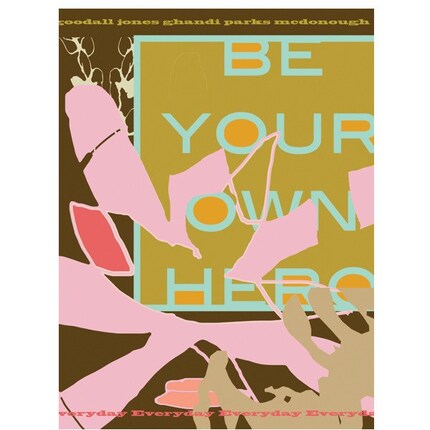 my creative process is that I try to let my pieces have a life of their own. I don't sit down for hours and plan them out. I may find inspiration in a song, a poster, a statement or perhaps a cause that I want to support and I then I let the ideas, images and text flow and see what happens; I try to let each piece evolve and speak for itself. If I misspell a word in the text on a print, I will usually leave it that way or if I move an image by mistake, I may take that as a sign that the piece was meant to take a different direction. I really try to let the piece have its own voice. This philosophy partly stems from my interest in the Dada art movement of the early 1900's. An element from this movement that always stuck with me was the idea of letting chance play a role in the creation of a piece because 'mistakes' are a real part of life and they are often what makes life, and in my opinion, art, most beautiful. For me, misspellings, overlapping and cut-off text and images, these are what give truth to my pieces and make them feel 'real' in the context of a world that is also seriously imperfect.
my creative process is that I try to let my pieces have a life of their own. I don't sit down for hours and plan them out. I may find inspiration in a song, a poster, a statement or perhaps a cause that I want to support and I then I let the ideas, images and text flow and see what happens; I try to let each piece evolve and speak for itself. If I misspell a word in the text on a print, I will usually leave it that way or if I move an image by mistake, I may take that as a sign that the piece was meant to take a different direction. I really try to let the piece have its own voice. This philosophy partly stems from my interest in the Dada art movement of the early 1900's. An element from this movement that always stuck with me was the idea of letting chance play a role in the creation of a piece because 'mistakes' are a real part of life and they are often what makes life, and in my opinion, art, most beautiful. For me, misspellings, overlapping and cut-off text and images, these are what give truth to my pieces and make them feel 'real' in the context of a world that is also seriously imperfect.Above right: "Own Hero" by Art for Change
What is the name of your etsy shop?
My shop is called Art For Change. Of course, most importantly this name means that I want my art to support positive change and movement in this world. However, it is also an important part of my philosophy to keep my prices affordable so that more people can enjoy non-mass- produced art in their homes. So, the name Art For Change can have that dual meaning of change as in an evolution (or hopefully revolution!) or change as in coins. I like the fact that it has that ability to be read in two ways. (Readers may also like to visit my other website, Sarah Meredith Gallery.)




